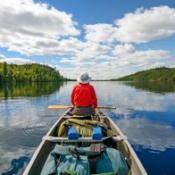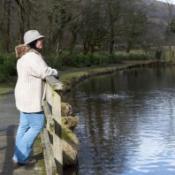 Here in Southern California, fierce winter storms have finally dissolved into a warm springtime, and many thousands of people are totally enraptured by the “super bloom” of wildflowers. Cars clog the usually sparse desert roads in Anza-Borrego, its desert plains no longer barren. Traffic jams form near Lake Elsinore, as city dwellers hop out of their cars to frolic (and take selfies) in the fields of blossoms. They keep coming, people of all cultures, ages, and persuasions; their photos flood social media. I’m thrilled to observe the enthusiasm and wonder for nature, even while ironically noting the extra car trips generated by this enchantment.
Here in Southern California, fierce winter storms have finally dissolved into a warm springtime, and many thousands of people are totally enraptured by the “super bloom” of wildflowers. Cars clog the usually sparse desert roads in Anza-Borrego, its desert plains no longer barren. Traffic jams form near Lake Elsinore, as city dwellers hop out of their cars to frolic (and take selfies) in the fields of blossoms. They keep coming, people of all cultures, ages, and persuasions; their photos flood social media. I’m thrilled to observe the enthusiasm and wonder for nature, even while ironically noting the extra car trips generated by this enchantment.
Like the wildflowers, the background to this picture is also unusually intense, as our current federal administration threatens to deconstruct many of the laws and agencies protecting both flora and fauna. This only turns up the already existing eco-anxiety to levels heretofore unseen.
Eco-anxiety is exactly what it sounds like: anxiety in response to information that the earth and its ecosystems are suffering. And they are indeed suffering, as evidenced by multitudes of statistics on climate change, melting glaciers, submerging islands, and shrinking freshwater tables; rainforests vanishing into beef farms; extinctions, diminishing open spaces, and rampant poaching; and acidifying seas with radioactive runoff, giant gyres of plastic, and declining fish populations.
Including environmental awareness and anxiety in mental health treatment is a relatively new, but growing, phenomenon. Many of us feel it’s a necessary adaptation of our field in response to changing global circumstances. Sarah Anne Edwards and Linda Buzzell describe a “waking-up syndrome” in which people feel anxiety in response to their growing awareness about what is happening to our natural environment. As Buzzell explains in The Huffington Post, there are “psychological stages people go through as they become fully aware of the extent of the environmental threat. One of these stages involves ‘eco-anxiety,’ a state of persistent fear about the very real crisis we face that can be at the core of many … environmental depressions.”
In previous articles on this site, I’ve written extensively about the autonomic nervous system and its attempts to protect us via the fight, flight, and freeze responses. Eco-anxiety is no different. It is normal to feel intense anxiety at the thought of the web of life disappearing. If it disappears, so do we. What is perhaps normal, but not functional, is to feel such anxiety to the degree we are immobilized and don’t do anything about the problem. (Remember the freeze response—which is closely related to dissociation, depression, and denial.) The problems seem so big and overwhelming we turn away because we don’t feel there’s anything we can really do.
With all that in mind, here are some points I would like to share regarding eco-anxiety and what we can do about it:
All life as we know it is dependent on this fragile biosphere we live in, at least for the immediately foreseeable future. It is normal to feel threatened and upset by unrelenting potential (and actual) devastation of our natural environment. In fact, it is inappropriate to extinguish anxiety (that is, “turn off the fire alarm”) when a major threat continues to loom.
- It is totally normal to feel anxiety at the thought of environmental devastation. I know I just said that, but it bears repeating, especially in light of those who would minimize our feelings. “You’re overreacting. It’s just something we have to live with. Humans always find a way to overcome!” Nonsense. All life as we know it is dependent on this fragile biosphere we live in, at least for the immediately foreseeable future. It is normal to feel threatened and upset by unrelenting potential (and actual) devastation of our natural environment. In fact, it is inappropriate to extinguish anxiety (that is, “turn off the fire alarm”) when a major threat continues to loom.
- Trauma is a normal reaction to abnormal circumstances. (Credit Dr. Peter Levine for this clarification.) Traumatic stress often includes avoidance of related stimuli. The extent to which our environment is under attack is clearly neither normal nor natural. When something is overwhelming, we turn away because it feels terrible. This is totally understandable, but of course not very effective in neutralizing the threats.
- Healing involves moving from helplessness into efficacy. Just like with any trauma, it is healthier (and usually feels much better) to be actively dealing with the problem rather than avoiding it. The trick is getting ourselves mobilized into making this transition.
- Taking action involves breaking the huge problem down into manageable parts, then taking on one small part at a time. I’m sure, by now, we can all generate big lists of “things to do that are good for the environment”: Use canvas grocery bags instead of paper or plastic. Walk or bicycle instead of drive. Compost food scraps. Reduce consumption of animal products. Etcetera. In somatic psychotherapy, we like to take a small, gentle action, then “track” or carefully notice the effect on our physical body via the felt sense. So, then! Why not actually go and do one of these small actions, then observe how it makes you feel? One of my favorites is planting native plants—ones that naturally occur in my geographic area. This directly supports local wildlife. I’m in the process of planting my second native plant garden. My first, which still exists at my old house, continues to attract an amazing variety of local fauna: varied and fascinating insects including many species of butterflies, grasshoppers, and ladybugs; hummingbirds, sparrows, and other birds (up to and including hawks!); and possums, skunks, and more. It is very satisfying to observe these animals enjoying a home I directly re-created for them within an urban environment.
- The first part of the cure is for people to enjoy spending time in nature. Nature is not just for little kids, to be discarded like a worn-out child’s toy when the child grows into the “sophistications” of adulthood. It is normal and (fortunately) common to draw great comfort and ease from many aspects of being in nature. Many studies have shown improvements in task performance, or reduction in depression scores, with simple exposures to natural objects such as trees.
So why not? Get out there and recharge your battery—allow nature to help you feel good. For people who have a difficult time experiencing nature due to mobility, economic, or logistical issues, nature can come to you, often very simply: You can watch one of many television programs by Sir David Attenborough, treasured naturalist of the United Kingdom. Or, find a plant that smells good, or a flower that brings you enjoyment—even a photograph of a flower or nature scene. Contemplate it for a while. Or, observe the ways in which nature finds a way in the big city: green sprouts growing through pavement, sparrows swooping and twittering in the park trees, ants hustling to bring food into their nest under a sidewalk. Notice how you feel in your body as you make these observations. Share this with your friends and family. And as we say in somatic therapy, “See what happens next!”
This is how it begins. Many famous activists never dreamed they’d be fighting for change; they simply connected with what was important to them and allowed passion and circumstance to guide them. I invite you to leave a comment here about your favorite nature place and how it affects you.
References:
- Bushak, L. (2013). Benefits of Ecotherapy: Being in Nature Fights Depression, Improves Mental Health and Well-Being. Retrieved from: http://www.medicaldaily.com/benefits-ecotherapy-being-nature-fights-depression-improves-mental-health-and-well-being-261075
- Buzzell, L. (2009). TIME Article on Eco-Therapy. The Huffington Post. Retrieved from http://www.huffingtonpost.com/linda-buzzell/emtimeem-article-on-eco-t_b_246561.html
- Edwards, S.A., & Buzzell, L. (2009). The Waking Up Syndrome. In Buzzell, L. and Chalquist, C. (eds.) (2009). Ecotherapy: Healing with Nature In Mind. San Francisco, CA: Sierra Club Books.
- Levine, P. (1997). Waking the Tiger: Healing Trauma. Berkeley, CA: North Atlantic Books.
© Copyright 2017 GoodTherapy.org. All rights reserved.
The preceding article was solely written by the author named above. Any views and opinions expressed are not necessarily shared by GoodTherapy.org. Questions or concerns about the preceding article can be directed to the author or posted as a comment below.

 5 Ways Nature Can Help You Feel Better
5 Ways Nature Can Help You Feel Better 5 Therapeutic Ways to Heal Separation or Divorce with Nature
5 Therapeutic Ways to Heal Separation or Divorce with Nature Is Time Outdoors the Key to Helping Veterans Overcome PTSD?
Is Time Outdoors the Key to Helping Veterans Overcome PTSD?